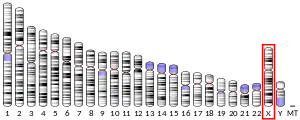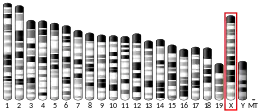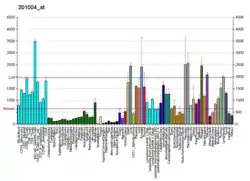SSR4
Translocon-associated protein subunit delta is a protein that in humans is encoded by the SSR4 gene.[5][6]
| SSR4 | |||||||||||||||||||||||||||||||||||||||||||||||||||
|---|---|---|---|---|---|---|---|---|---|---|---|---|---|---|---|---|---|---|---|---|---|---|---|---|---|---|---|---|---|---|---|---|---|---|---|---|---|---|---|---|---|---|---|---|---|---|---|---|---|---|---|
| Identifiers | |||||||||||||||||||||||||||||||||||||||||||||||||||
| Aliases | SSR4, TRAPD, CDG1Y, signal sequence receptor subunit 4 | ||||||||||||||||||||||||||||||||||||||||||||||||||
| External IDs | OMIM: 300090 MGI: 1099464 HomoloGene: 4573 GeneCards: SSR4 | ||||||||||||||||||||||||||||||||||||||||||||||||||
| |||||||||||||||||||||||||||||||||||||||||||||||||||
| |||||||||||||||||||||||||||||||||||||||||||||||||||
| |||||||||||||||||||||||||||||||||||||||||||||||||||
| |||||||||||||||||||||||||||||||||||||||||||||||||||
| Wikidata | |||||||||||||||||||||||||||||||||||||||||||||||||||
| |||||||||||||||||||||||||||||||||||||||||||||||||||
SSR4, also called TRAPD, is assumed to be involved in protein secretion. It is located in the Xq28 region, arranged in a compact head-to-head manner with the IDH3G gene. These two genes are driven by a bidirectional promoter located between them and encode proteins involved in unrelated biochemical pathways located in different compartments of the cell. The nontranscribed intergenic region represents only 133 bp and is embedded in a CpG island. The CpG island functions as a bidirectional promoter to initiate the transcription of both functionally unrelated genes with distinct expression patterns. SSR4 consists of six exons and is approximately 70 kb telomeric length from the ALD gene. Although alternative splicing of exon 5 has not been detected in the human SSR4 gene, transcript variants missing the region homologous to the human exon 5 have been detected in both Xenopus laevis and Mus musculus.[6]
References
- GRCh38: Ensembl release 89: ENSG00000180879 - Ensembl, May 2017
- GRCm38: Ensembl release 89: ENSMUSG00000002014 - Ensembl, May 2017
- "Human PubMed Reference:". National Center for Biotechnology Information, U.S. National Library of Medicine.
- "Mouse PubMed Reference:". National Center for Biotechnology Information, U.S. National Library of Medicine.
- Brenner V, Nyakatura G, Rosenthal A, Platzer M (Nov 1997). "Genomic organization of two novel genes on human Xq28: compact head to head arrangement of IDH gamma and TRAP delta is conserved in rat and mouse". Genomics. 44 (1): 8–14. doi:10.1006/geno.1997.4822. PMID 9286695.
- "Entrez Gene: SSR4 signal sequence receptor, delta (translocon-associated protein delta)".
Further reading
- Holthuis JC, van Riel MC, Martens GJ (1996). "Translocon-associated protein TRAP delta and a novel TRAP-like protein are coordinately expressed with pro-opiomelanocortin in Xenopus intermediate pituitary". Biochem. J. 312 ( Pt 1) (Pt 1): 205–13. doi:10.1042/bj3120205. PMC 1136246. PMID 7492314.
- Hartmann E, Görlich D, Kostka S, et al. (1993). "A tetrameric complex of membrane proteins in the endoplasmic reticulum". Eur. J. Biochem. 214 (2): 375–81. doi:10.1111/j.1432-1033.1993.tb17933.x. hdl:11858/00-001M-0000-0015-3BD2-F. PMID 7916687.
- Wang L, Dobberstein B (1999). "Oligomeric complexes involved in translocation of proteins across the membrane of the endoplasmic reticulum". FEBS Lett. 457 (3): 316–22. doi:10.1016/S0014-5793(99)01075-3. PMID 10471800.
- Hartley JL, Temple GF, Brasch MA (2001). "DNA Cloning Using In Vitro Site-Specific Recombination". Genome Res. 10 (11): 1788–95. doi:10.1101/gr.143000. PMC 310948. PMID 11076863.
- Strausberg RL, Feingold EA, Grouse LH, et al. (2003). "Generation and initial analysis of more than 15,000 full-length human and mouse cDNA sequences". Proc. Natl. Acad. Sci. U.S.A. 99 (26): 16899–903. Bibcode:2002PNAS...9916899M. doi:10.1073/pnas.242603899. PMC 139241. PMID 12477932.
- Miyazaki K, Fujita T, Ozaki T, et al. (2004). "NEDL1, a novel ubiquitin-protein isopeptide ligase for dishevelled-1, targets mutant superoxide dismutase-1". J. Biol. Chem. 279 (12): 11327–35. doi:10.1074/jbc.M312389200. PMID 14684739.
- Ota T, Suzuki Y, Nishikawa T, et al. (2004). "Complete sequencing and characterization of 21,243 full-length human cDNAs". Nat. Genet. 36 (1): 40–5. doi:10.1038/ng1285. PMID 14702039.
- Wang Z, VandeBerg JL (2005). "Cloning and molecular characterization of a human ortholog of Monodelphis TRAPD in ultraviolet B-induced melanoma". Melanoma Res. 14 (2): 107–14. doi:10.1097/00008390-200404000-00005. PMID 15057039. S2CID 12281868.
- Gerhard DS, Wagner L, Feingold EA, et al. (2004). "The Status, Quality, and Expansion of the NIH Full-Length cDNA Project: The Mammalian Gene Collection (MGC)". Genome Res. 14 (10B): 2121–7. doi:10.1101/gr.2596504. PMC 528928. PMID 15489334.
- Wiemann S, Arlt D, Huber W, et al. (2004). "From ORFeome to Biology: A Functional Genomics Pipeline". Genome Res. 14 (10B): 2136–44. doi:10.1101/gr.2576704. PMC 528930. PMID 15489336.
- Mehrle A, Rosenfelder H, Schupp I, et al. (2006). "The LIFEdb database in 2006". Nucleic Acids Res. 34 (Database issue): D415–8. doi:10.1093/nar/gkj139. PMC 1347501. PMID 16381901.
- Ewing RM, Chu P, Elisma F, et al. (2007). "Large-scale mapping of human protein–protein interactions by mass spectrometry". Mol. Syst. Biol. 3 (1): 89. doi:10.1038/msb4100134. PMC 1847948. PMID 17353931.




